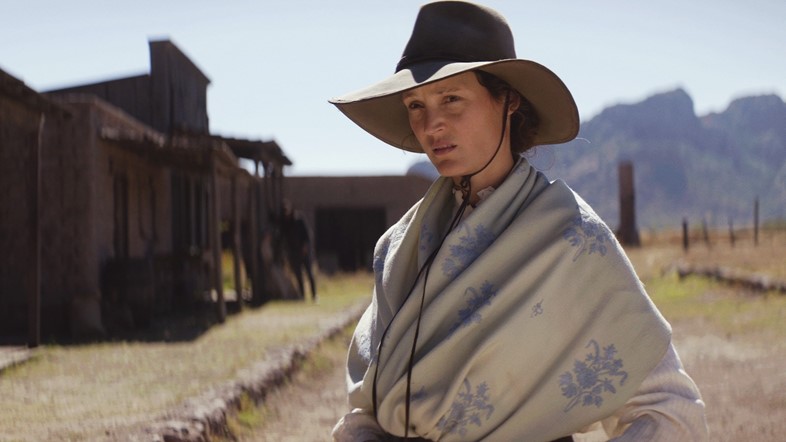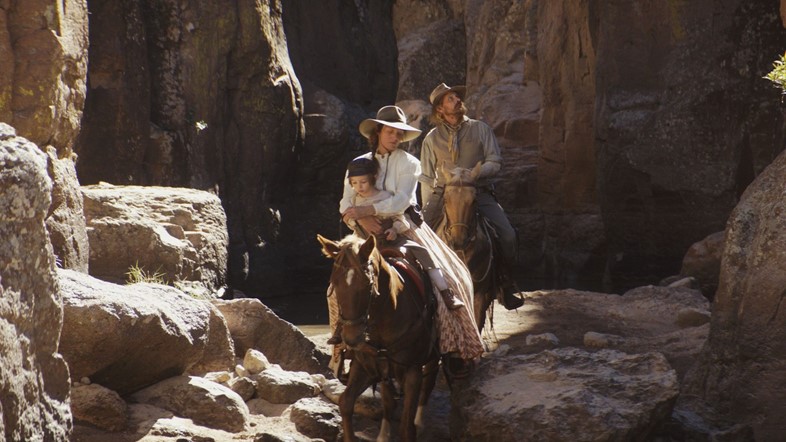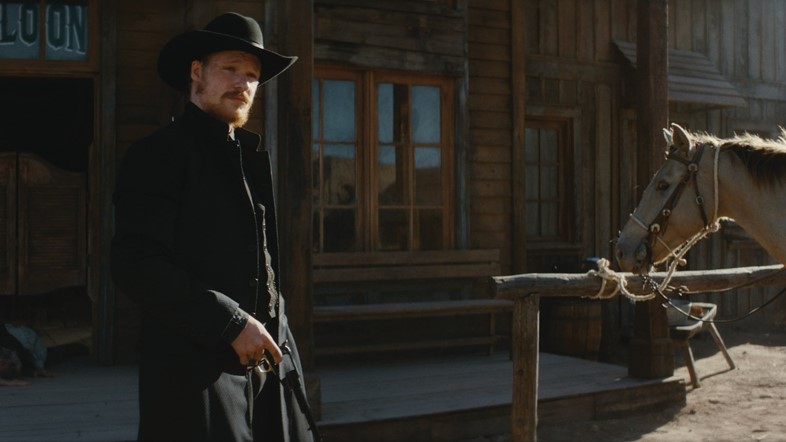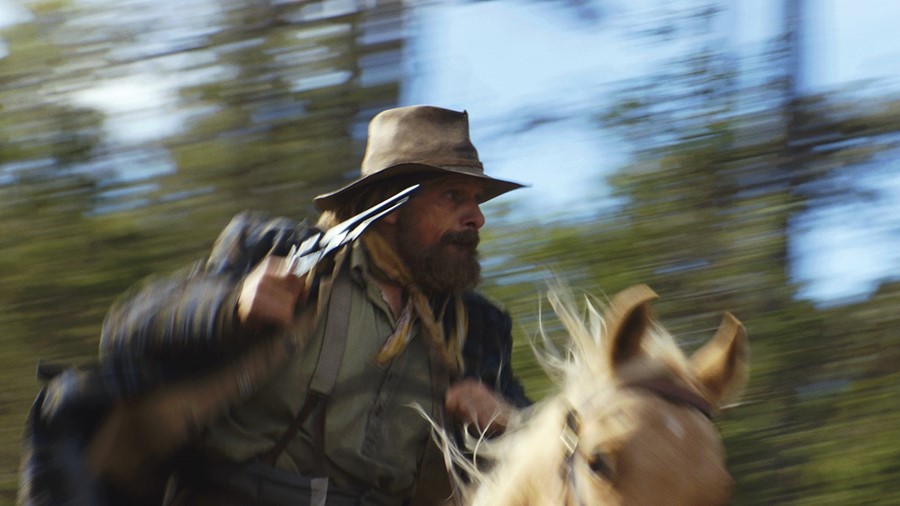Written, produced and directed by Viggo Mortensen, who also stars, The Dead Don’t Hurt is a gentle take on the western genre that places a woman’s experience at its heart
Viggo Mortensen has watched western films all his life. When asked which are the most significant to him, he rattles off a long list of favourites – Red River, Stagecoach, The Oxbow Incident – but now, in only his second outing as a director, he’s finally made one of his own.
Set in the American frontier of the 1860s, The Dead Don’t Hurt follows the story of a French-Canadian woman called Vivienne (played by Vicky Krieps) and a Danish immigrant called Holger (Mortensen), who come together and embark on a relationship. Their romance plays out against a backdrop of violence, focusing on Vivienne’s experience as Holger – known as ‘Olsen’ – goes to war, leaving her behind.
Mortensen didn’t only direct The Dead Don’t Hurt, he also wrote, produced and composed the score for it – something he also did for his previous film, Falling (2020). Speaking to the director, it’s clear that this film was a labour of love for him. And while it’s set in a time and place that is very far removed from our current realities, it speaks to very prescient themes: love, war, masculinity and violence.
Here, Mortensen delves into this project in more detail, discussing how The Dead Don’t Hurt came to fruition, the influence The Lord of the Rings has had on him as a filmmaker, and what he hopes viewers will take away from it.

Ted Stansfield: Can I start by asking what drew you to the western genre?
Viggo Mortensen: I grew up watching a lot of westerns, like many boys in my generation – many more than kids see today in movie theatres and on TV. As an adult, I have continued to view them, rewatching the ones I saw as a boy and finding many others I’d not seen before. Most of them, as is the case with most movies in any genre, are not what I would call well-made, original stories. However, even in many of the lacklustre ones, there are story elements, performances and landscapes that are worth a look, that one can learn from. In preparation for shooting The Dead Don’t Hurt, I watched hundreds of them. There were many details regarding set design, horsemanship, costumes and photography that were useful to me, many of which I shared with members of our team in preparation for filming.
TS: Which were most significant to you?
VM: There are many that I’ve found, in whole or in part, instructive and enjoyable. Too long a list to give here. Although only a partial list of those I value, among titles perhaps most recognisable to fans of the genre are movies like Red River, Stagecoach, The Oxbow Incident, Seven Men From Now, Decision at Sundown, The Man Who Shot Liberty Valance, Forty Guns, Lonely Are the Brave, The Outlaw Josey Wales, Day of the Outlaw, The Missouri Breaks and McCabe and Mrs Miller, to name a few.
TS: What were you wanting to add to this canon; what kind of western story were you wanting to tell?
VM: I was not conscious of trying to add anything specifically new, to in any way “reinvent” within the genre. Our primary aim was to make a well-written, truthfully performed and efficiently shot movie. It is photographed in a fairly straightforward way, as [Howard] Hawks or [Budd] Boetticher might have done, and we made every effort to ensure that the look of the characters, buildings, weapons, horsemanship and landscapes were authentic to the period the story is set in. Perhaps somewhat unusual or different from most classic western stories is the fact that we focus on the main female character, and stay with her when her male partner goes off to war.

TS: I read that you wrote this film for your mother – can you tell me about that?
VM: During the 2020 Covid lockdown, when I started writing The Dead Don’t Hurt, the first image that came to me was of a girl like the girl my mother had been, playing and dreaming alone in a maple forest like those she knew in her childhood.
TS: And why did you want to cast Vicky in the role of Vivienne? What was it like working with her?
VM: I could not imagine anyone better in this role than Vicky Krieps, and we were very happy when she told me she liked the character and wanted to play her. She is inspired and very original in her approach to the work. Completely engaged, never a false moment.
“I drew on aspects of people I know – my father, my grandfather and other Danish men I have known, heard of, or read about – to help construct Holger. The character has a particular kind of quiet stubbornness, a dry sense of humour and a sense of irony” – Viggo Mortensen
TS: I thought it was interesting when Holger asks Vivienne if she’s French and she said no, she’s American. I wondered what comment you wanted to make about immigrant/American identities in this film?
VM: No comment in particular. As this movie partly shows, the US had a richly varied population even then, and someone who does not speak English, or does so with an accent from another language, can be as American as anyone else.
TS: How do you relate to your own American identity?
VM: I accept it.
TS: Holger is Danish, like you, and I’m curious to know what aspects of Danishness you wrote into his character?
VM: I drew on aspects of people I know – my father, my grandfather and other Danish men I have known, heard of, or read about – to help construct Holger’ The character has a particular kind of quiet stubbornness, a dry sense of humour and a sense of irony. He also is willing to learn and steadily evolve as a person. He says the odd thing in Danish to Little Vincent, his adoptive son, just as Vivienne speaks in French with the boy. This seemed natural and logical, and I believe it added a layer of realistic detail to the family relationships.

TS: I thought it was interesting when the young Vivienne asks her mother why men fight and she says, “It’s complicated.” What elements of masculinity were you wanting to explore in this film?
VM: I wanted to explore what happens to the women who are left behind when their fathers, husbands, or sons go away to fight their masculine wars. And what little girls like Vivienne feel and think about that.
TS: You composed the music for this film. Why did you decide to do this, and can you tell me about this process?
VM: I also did it for my first movie, Falling. In one sense it was practical and inexpensive to do so. On a creative level, the music, much of which was composed and recorded before filming, helped me design the length and rhythm of many scenes. It might sound counter-intuitive to create a lot of the music before shooting, but in both movies, it proved helpful as a guide for shooting and editing them.
“I learned to ride at a very young age, and always enjoy being around [horses]. This was, of course, very helpful when I had scenes on horseback in the Lord of the Rings trilogy, and also helped me play Olsen in The Dead Don’t Hurt” – Viggo Mortensen
TS: I’d love to know what kind of influence The Lord of the Rings – that whole experience – has had on you not only as an actor but as a writer and director, too.
VM: What Peter Jackson and his team managed to do, how they overcame physical and logistical obstacles and, in the course of doing so, came up with original solutions to filmmaking problems, was a great learning experience for all of us who participated in that long three-movie shoot. It was a very impressive team effort. The truly collective aspect of the work done for that epic production in New Zealand provided us with a lot of inspiration. It was like a big, practical film school constantly on the move, constantly evolving and striving to improve as it went along.
TS: What is your relationship with Aragorn, with that character, like now?
VM: I have very fond memories of working on that character – by far the longest period of time I’ve ever been given to develop one – and especially of the camaraderie that developed among the actors and crew members I was fortunate to work with every day.
TS: There’s a lot of you on horseback in this film, as with LOTR, and I noticed that the horses were included in the credits of The Dead Don’t Hurt – can you tell me about your love for horses?
VM: I learned to ride at a very young age, and always enjoy being around them. This was, of course, very helpful when I had scenes on horseback in the trilogy, and also helped me play Olsen in The Dead Don’t Hurt. Having an understanding of horses and how people ought to behave on or around them also helped me direct and edit scenes in the movie.

TS: The cinematography of the film is very beautiful, especially with the natural landscapes. Why were these shots of nature important for you to include?
VM: They were both realistic and attractive places to shoot in for this kind of story. Physical landscapes are important characters in many movies, especially in most westerns. Marcel Zyskind [the cinematographer] did a wonderful job of showing the places we see in a straightforward and handsome way, without drawing unnecessary attention to how the camera sees them. To the point, not showy, just as happens in most classic Westerns.
TS: What do you hope viewers will take away from this film?
VM: I hope they will fall in love with Vivienne, as Olsen and our filmmaking team did, that they will be moved to feel and think about how men and women relate to each other, that they might consider the wastefulness and sadness that any war brings, and that seeing the film will spark their desire to see more westerns.
The Dead Don’t Hurt will premiere at the Glasgow Film Festival on March 3 and 4. Viggo Mortensen will also be ‘in conversation’ at the festival on March 3. Signature Entertainment will then release the film in UK and Irish cinemas this summer.
